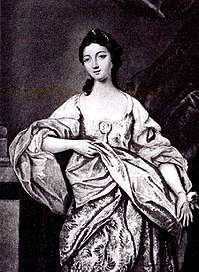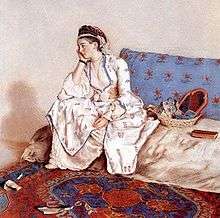Maria Coventry, Countess of Coventry
.jpg)
Maria Coventry, Countess of Coventry (née Gunning; 1733 – 30 September 1760) was a famous Irish beauty and London society hostess during the reign of King George II. She died at a young age from lead and mercury poisoning, killed by the toxins used in her beauty regimen.[1]
Biography

Maria was born in Hemingford Grey, Huntingdonshire and was the eldest child of John Gunning of Castle Coote, County Roscommon and his wife Hon. Bridget Bourke, daughter of Theobald Bourke, 6th Viscount Mayo (1681–1741). Maria's younger siblings were Elizabeth Gunning, Duchess of Hamilton and Argyll, Catherine (married Robert Travis, died 1773), Sophia, Lizzie and John (a general in the army).[2]
In late 1740 or early 1741, the Gunning family returned to John Gunning's ancestral home in Ireland, where they divided their time between their home in Roscommon and a rented house in Dublin. According to some sources, when Maria and her sister Elizabeth came of age, their mother urged them to take up acting in order to earn a living, owing to the family's relative poverty. The sources further state that the Gunning sisters worked for some time in the Dublin theatres, befriending actors like Peg Woffington, even though acting was not considered a respectable profession, as many actresses doubled as courtesans to wealthy benefactors. However, other sources deny this and point out that Margaret Woffington did not arrive in Dublin until May 1751, by which time Maria and her sister Elizabeth were in England.

Kitty Fisher answered she ..."had better ask Lord Coventry as he had given her the dress as a gift."
The altercation continued with Lady Coventry calling her an impertinent woman.
Kitty replied that she ... "would have to accept this insult because Maria was socially superior since marrying Lord Coventry, but she was going to marry a Lord herself just to be able to answer back."
Giustiniana Wynne, visiting London at the time.[3]
In October 1748, a ball was held at Dublin Castle by the Viscountess Petersham. The two sisters did not have any dresses for the gathering until Tom Sheridan, the manager of one of the local theatres, supplied them with two costumes from the green room, those of Lady Macbeth and Juliet. Wearing the costumes, they were presented to the Earl of Harrington, the then-Lord Lieutenant of Ireland. Harrington must have been pleased by the meeting as, by 1750, Bridget Gunning had persuaded him to grant her a pension, which she then used to transport herself, Maria and Elizabeth back to their original home in Huntingdon, England. With their attendance at local balls and parties, the beauty of the two girls was much remarked upon. They became well-known celebrities, their fame reaching all the way to London. On 2 December 1750, they were presented at the court of St James, at which time they were sufficiently famous that the presentation was noted in the London newspapers. Maria, who was notoriously tactless, was reported to have made a notable gaffe by telling the elderly George II that the spectacle she would most like to see was a royal funeral. Fortunately, the king was highly amused.
Within a year, Elizabeth had married the Duke of Hamilton. In March 1752, Maria married the 6th Earl of Coventry and became the Countess of Coventry. For their honeymoon, the earl and countess traveled around Europe accompanied by Lady Petersham, but neither lady enjoyed it much, especially Maria, who particularly disliked Paris. The countess' ignorance of the French language and her husband's decision not to allow her to wear red powder as makeup (which was fashionable in Paris at the time) intensified her dislike of the city and the trip. On one occasion, her husband saw her arrive at dinner with powder on her face and tried to rub it off with his handkerchief. Her tactlessness, which had amused George II, struck the French court as simply bad manners.
Maria's popularity and beauty was such that on her return to London, she was mobbed when she appeared in Hyde Park and was eventually given a guard by the king, led by the Earl of Pembroke. Her husband became involved with the then-famous courtesan Kitty Fisher, which caused Maria much distress.
Maria also became involved in at least one affair. She was rumoured to have been involved romantically with the 3rd Duke of Grafton, but this was never confirmed beyond doubt.[4]
Death
Maria's early death (at the age of 27) on 30 September 1760 was caused by lead poisoning from the makeup she wore, which was very stylish at the time. Throughout the 17th and 18th centuries, it was fashionable for ladies to have pale white skin and red rouged cheeks; to achieve this look, lead-based Venetian ceruse was often used. The noxious effects of lead caused skin eruptions, which then encouraged ladies to apply more ceruse to cover the blemishes, eventually causing blood poisoning.
Originally known simply as a beautiful but vain woman, Maria eventually became known in society circles as a "victim of cosmetics".[5]
References
- ↑ Oliver, Amy (29 May 2012). "Vanity mirror used by tragic 18th century society beauty, 27, who died of make-up poisoning sells for £300,000". The Daily Mail. Retrieved 23 July 2017.
- ↑ Mosley, Charles, ed. (2003). Burke's Peerage, Baronetage & Knighthood (107 ed.). Burke's Peerage & Gentry. p. 929. ISBN 0-9711966-2-1.
- ↑ Baytun History, Sir Andrew Baytun Rolt
- ↑ "Archived copy". Archived from the original on 11 March 2007. Retrieved 2006-05-16.
- ↑ Brooks, John. "Maria Gunning, Countess of Coventry". Retrieved 17 April 2018.
External links
| Wikimedia Commons has media related to Maria Coventry, Countess of Coventry. |